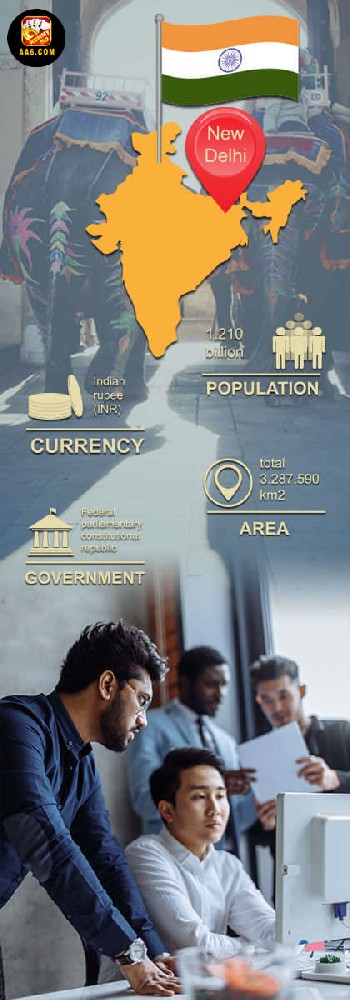Indian Market Information
• Introduction to the Indian BC Market
India is the second most populous country in the world and is currently the most eye-catching emerging market. However, in addition to Indian curry, Bollywood movies and Indian magic oil, there are many things that investors need to know before entering the mysterious India. Let the editor of Shaojiuzhu explain it to you~
• India has a huge population and growth potential
There are 7.6 billion people in the world, of which 3.5 billion people do not have access to the Internet, and about 1/4 are in India. The Internet penetration rate in India is about 35%, but the country with the largest number of Facebook and Whatsapp users is in India, and the world's second largest mobile application market is also in India. Imagine how big the market will be when India's penetration rate reaches universal. And 80% of the Indian Internet population access the Internet through mobile phones. This huge population can still provide such a huge scale under the condition of low Internet penetration rate.
• The Indian e-commerce market is a battlefield for Americans
The first brand of Indian e-commerce is Flipkart, and the second is Amazon. Both have a market share of 30% and are comparable. Flipkart was founded by two Indian Institute of Technology alumni. Initially, it was mainly engaged in book sales. The company grew through the acquisition of competitors and the right business strategy and became one of the largest e-commerce companies in India. After Flipkart acquired 77% of Walmart's shares in 2017, the e-commerce war in India became a war between American companies. The other shareholders behind Flipkart are Softbank, Tencent and Microsoft.
• The two digital services with the highest market share in India are both invested by Alibaba Group
UC Browser is the first Chinese Internet company to enter the Indian market. In the early days, it focused on web page compression, which was greatly welcomed in the Indian market with slow Internet speed. Alibaba acquired UC in 2014. UC Browser accounts for about 44% of the market in India, surpassing Chrome browser.
Next is Paytm, in which Alibaba Group holds a 36% stake. Paytm's initial business model was mainly mobile phone recharge payment, and then gradually developed to electricity bills, energy bills, and telephone bill payments. After Alibaba's Ant Financial invested, the business scope continued to expand to travel reservations, online ticketing, etc. In recent years, users have surpassed Paypal to become the world's third largest e-wallet.
• Indian users are very sensitive to the price of data consumption
In India, the mainstream method of data billing is "pay as you go". Unlike Asia's all-you-can-eat services, operators usually include data as a premium add-on in call plans. Therefore, Indians are very cautious about the use of data and only use it when necessary. Data is usually used to check emails and use mobile payments, but not necessarily for entertainment purposes.
• Compared with the scale of users, India's Internet revenue is less than expected
Compared with India's huge Internet population, India's Internet revenue is relatively small, and companies that are now investing in India are more betting on the future possibilities of this market.
Taking the advertising market as an example, India's national digital advertising expenditure in 2018 was only US$1.5 billion, which is only a drop in the ocean compared to China's digital advertising expenditure of US$85 billion and the largest advertising country, the United States, with US$105 billion. The reason is that India's per capita GDP is relatively low. In 2018, India's GDP was about US$2,020, which is about four times the GDP of China, which has a similar population of US$9,500.
However, India is one of the few countries in the world with a large population and a GDP growth rate that exceeds that of China. The market is optimistic about its future potential, just like investing, and is optimistic about its long-term value and making early investments.
• iPhone has a very low market share in India
Apple phones only account for 2% of the Indian market, but Xiaomi, OPPO, and Vivo together account for more than half of the Indian mobile phone market. In order to adapt to the offline physical market in India, the number of Xiaomi stores in India is even greater than that of local stores in China. However, I wonder if the recent Sino-Indian conflict will change this market pattern?
• Many Internet companies have developed localized products for the Indian market
In order to adapt to the particularity of the Indian market, Google has developed Android One for its low-performance hardware, which is designed for price-sensitive countries like India. At the same time, it has also developed several products for India. In addition, India is a country that advocates cricket. Therefore, Netflix did not cater to the local Indian audience, but also filmed "Cricket Boys" to win the favor of the Indian market.
A simple introduction to the Indian market, but this is only the beginning. When entering the market, you must also consider various factors such as humanities and customs. In the future, Shaojiuzhu Xiaobian will collect more information to talk to you about the caste system, Indian lottery culture, and other related information.



